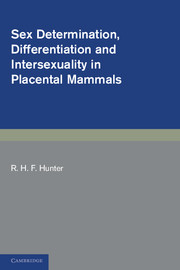Book contents
- Frontmatter
- Contents
- Preface
- Acknowledgements
- List of abbreviations
- List of gene abbreviations
- 1 Historical landmarks in studies of reproduction and sex determination
- 2 Mechanisms of sex determination
- 3 Differentiation of the gonads
- 4 Differentiation of the genital duct system
- 5 Anomalous sexual development in domestic species
- 6 Abnormal sexual development in laboratory rodents
- 7 Abnormal sexual development in man
- 8 Sexual differentiation in chimaeras
- 9 Asymmetries in the reproductive system and their significance
- 10 Concluding thoughts and a current perspective
- Index
- Plate section
5 - Anomalous sexual development in domestic species
Published online by Cambridge University Press: 05 March 2012
- Frontmatter
- Contents
- Preface
- Acknowledgements
- List of abbreviations
- List of gene abbreviations
- 1 Historical landmarks in studies of reproduction and sex determination
- 2 Mechanisms of sex determination
- 3 Differentiation of the gonads
- 4 Differentiation of the genital duct system
- 5 Anomalous sexual development in domestic species
- 6 Abnormal sexual development in laboratory rodents
- 7 Abnormal sexual development in man
- 8 Sexual differentiation in chimaeras
- 9 Asymmetries in the reproductive system and their significance
- 10 Concluding thoughts and a current perspective
- Index
- Plate section
Summary
Introduction
Anomalous sexual development in domestic farm animals has been recognised since ancient times, and overtly bizarre conditions appear to have enjoyed special significance in the fertility rites of various societies. Indeed, what might be regarded as selective breeding programmes were even imposed to generate an increased incidence of such animals on islands of the New Hebrides (see Baker, 1925). Because anatomical and behavioural abnormalities have attracted attention for many years, quite detailed reports exist for diverse conditions in cattle (Marcum, 1974), sheep (Bruere & Macnab, 1968), goats (Hamerton et al., 1969) and pigs (Crew, 1924; Baker, 1925; Brambell, 1929; Breeuwsma, 1970). In a majority of these reports, the emphasis was descriptive rather than analytical, well illustrated as long ago as 1779 when John Hunter was drawing attention to the problem of freemartinism in cattle. More recent studies have progressed from morphological and histological observations to karyotyping and chromosome banding studies in a search for possible genetic lesions underlying the aetiology of sexual abnormalities. However, a molecular approach involving, for example, the use of probes for Y-related DNA sequences is still in its relative infancy in farm animals, even though such probes are becoming available in domestic species for the purpose of monitoring the success of treatments to select or predetermine the sex of embryos prior to transplantation (Kirkpatrick & Monson, 1993; Machaty et al., 1993).
The anomalous development referred to in the first sentence of this introduction invariably concerns anatomical aberrations of a female reproductive tract and gonads that have been taken to reflect an intersex condition (reviews by Biggers & McFeely, 1966; Biggers, 1968; Short, 1969; Bishop, 1972).
- Type
- Chapter
- Information
- Publisher: Cambridge University PressPrint publication year: 1995
- 2
- Cited by

